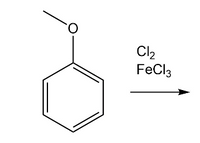
Chemistry
10th Edition
ISBN: 9781305957404
Author: Steven S. Zumdahl, Susan A. Zumdahl, Donald J. DeCoste
Publisher: Cengage Learning
expand_more
expand_more
format_list_bulleted
Concept explainers
Question
Draw the major organic product(s) for the reaction. Multiple products may be drawn in one box, in any order.

Transcribed Image Text:Cl,
FeCl3
Expert Solution
This question has been solved!
Explore an expertly crafted, step-by-step solution for a thorough understanding of key concepts.
This is a popular solution
Trending nowThis is a popular solution!
Step by stepSolved in 2 steps with 1 images

Knowledge Booster
Learn more about
Need a deep-dive on the concept behind this application? Look no further. Learn more about this topic, chemistry and related others by exploring similar questions and additional content below.Similar questions
- Consider the Friedel-Crafts (FC) alkylation of N-phenylacetamide (shown below) in which a reaction with 1-chloropropane and AlCl3 produces two isomers of isopropyl N-phenylacetamide. 1. Draw the complete reaction mechanism for the formation of the ortho product (para is also formed). 2. Is this reaction faster or slower than the similar FC reaction starting with benzene (C6H6)? Explain why. 3. Explain why this reaction produces the ortho and para products (but not meta). Use your mechanism to help explain parts #2 and #3. Use additional drawings and words as needed.arrow_forward10. Draw a complete curved arrow mechanism for the following reaction sequence. CC13H + KOt-Bu +arrow_forwardWhich is/are NOT TRUE about bimolecular nucleophilic substitution reactions? Select one or more: 1. A carbocation intermediate is formed. 2. A strong nucleophile displaces a halogen atom in a concerted mechanism. 3. Presence of polar aprotic solvents promotes this reaction. 4. Methyl halides react faster than secondary alkyl halides.arrow_forward
- Curved arrows are used to illustrate the flow of electrons. Using the provided starting structure, draw the curved electron-pushing arrows for the following reaction or mechanistic steps. Be sure to account for all bond-breaking and bond-making steps. Then draw the organic product of this reaction. Include all lone pairs in the structures. Ignore inorganic byproducts, counterions, and solvents. Incorrect, 2 attempts remaining H & H H Select to Add Arrows H₂O heat H :O: :Br: H H Select to Add Arrows H₂O heat Select to Draw Productarrow_forwardShow the mechanism by drawing curved arrows to represent the electron flow in the reactants.arrow_forwardPayalarrow_forward
- Draw the product for the substitution reactions below. Then, draw the proper FULL electron-pushing mechanism for the reaction, including intermediates with lone pairs and formal charges, and all electron pushing arrows (SN1 vs SN2). Label the electrophile and nucleophile in each step.arrow_forwardOn a scrap piece of paper, draw the curved arrow mechanism for the preferred reaction pathway of the following reaction. Assume an aqueous workup at the end of the reaction and draw the major organic products in the space provided. O O He NH₂ + Y N.arrow_forwardPlease solve this mechanism.arrow_forward
arrow_back_ios
arrow_forward_ios
Recommended textbooks for you
 ChemistryChemistryISBN:9781305957404Author:Steven S. Zumdahl, Susan A. Zumdahl, Donald J. DeCostePublisher:Cengage Learning
ChemistryChemistryISBN:9781305957404Author:Steven S. Zumdahl, Susan A. Zumdahl, Donald J. DeCostePublisher:Cengage Learning ChemistryChemistryISBN:9781259911156Author:Raymond Chang Dr., Jason Overby ProfessorPublisher:McGraw-Hill Education
ChemistryChemistryISBN:9781259911156Author:Raymond Chang Dr., Jason Overby ProfessorPublisher:McGraw-Hill Education Principles of Instrumental AnalysisChemistryISBN:9781305577213Author:Douglas A. Skoog, F. James Holler, Stanley R. CrouchPublisher:Cengage Learning
Principles of Instrumental AnalysisChemistryISBN:9781305577213Author:Douglas A. Skoog, F. James Holler, Stanley R. CrouchPublisher:Cengage Learning Organic ChemistryChemistryISBN:9780078021558Author:Janice Gorzynski Smith Dr.Publisher:McGraw-Hill Education
Organic ChemistryChemistryISBN:9780078021558Author:Janice Gorzynski Smith Dr.Publisher:McGraw-Hill Education Chemistry: Principles and ReactionsChemistryISBN:9781305079373Author:William L. Masterton, Cecile N. HurleyPublisher:Cengage Learning
Chemistry: Principles and ReactionsChemistryISBN:9781305079373Author:William L. Masterton, Cecile N. HurleyPublisher:Cengage Learning Elementary Principles of Chemical Processes, Bind...ChemistryISBN:9781118431221Author:Richard M. Felder, Ronald W. Rousseau, Lisa G. BullardPublisher:WILEY
Elementary Principles of Chemical Processes, Bind...ChemistryISBN:9781118431221Author:Richard M. Felder, Ronald W. Rousseau, Lisa G. BullardPublisher:WILEY

Chemistry
Chemistry
ISBN:9781305957404
Author:Steven S. Zumdahl, Susan A. Zumdahl, Donald J. DeCoste
Publisher:Cengage Learning

Chemistry
Chemistry
ISBN:9781259911156
Author:Raymond Chang Dr., Jason Overby Professor
Publisher:McGraw-Hill Education

Principles of Instrumental Analysis
Chemistry
ISBN:9781305577213
Author:Douglas A. Skoog, F. James Holler, Stanley R. Crouch
Publisher:Cengage Learning

Organic Chemistry
Chemistry
ISBN:9780078021558
Author:Janice Gorzynski Smith Dr.
Publisher:McGraw-Hill Education

Chemistry: Principles and Reactions
Chemistry
ISBN:9781305079373
Author:William L. Masterton, Cecile N. Hurley
Publisher:Cengage Learning

Elementary Principles of Chemical Processes, Bind...
Chemistry
ISBN:9781118431221
Author:Richard M. Felder, Ronald W. Rousseau, Lisa G. Bullard
Publisher:WILEY